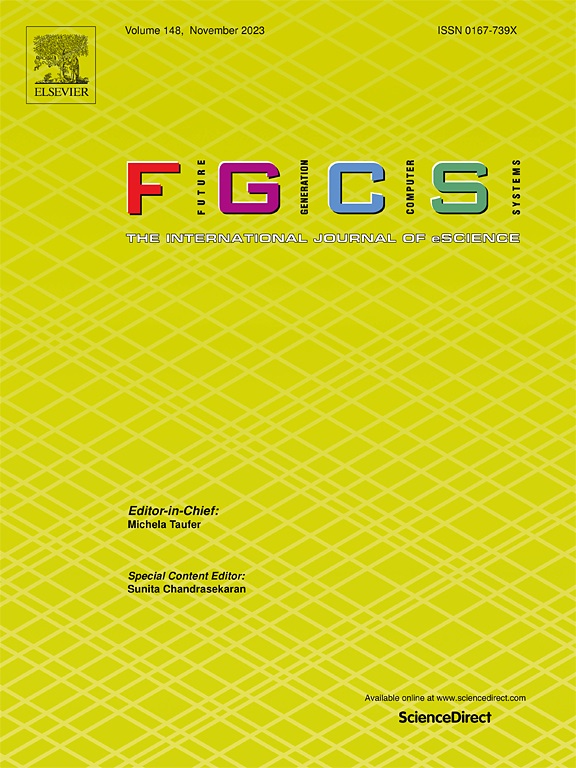Dimensioning network slices for power minimization under reliability constraints
IF 6.2
2区 计算机科学
Q1 COMPUTER SCIENCE, THEORY & METHODS
Future Generation Computer Systems-The International Journal of Escience
Pub Date : 2025-03-26
DOI:10.1016/j.future.2025.107824
引用次数: 0
Abstract
Network slicing allows multiplexing virtualized networks, called slices, over a single physical network infrastructure. Research has extensively focused on the placement of virtual functions and the links that compose each network slice. On the other hand, performance greatly depends on how many resources are allocated to virtual nodes and links, after they are placed. This aspect has been mostly neglected.
In this paper, we propose a method to dimension computation and network resources to slices, with the aim to minimize dynamic power consumption. Latency and power are the result of non-trivial couplings between different components of each slice. Therefore, minimizing power while satisfying the reliability constraints of all slices is challenging. To capture these couplings, we model slices as multiple Jackson networks (one per slice) co-existing in the same resource-constrained physical network. To the best of our knowledge, we are the first to employ Jackson Networks in such a setting. Dynamic power savings are in large part obtained by finely deciding CPU clock frequency, exploiting Dynamic Voltage Frequency Scaling (DVFS). Via numerical evaluation, we show that our method finds per each slice just the right amount of resources to satisfy latency constraints (expressed in probabilistic terms, as chance-constraints). This brings relevant dynamic power reduction with respect to baselines representing the state of the art in network slicing, which focuses on placement without specific strategies for resources dimensioning.
基于可靠性约束的功率最小化网络切片的尺寸划分
网络切片允许在单个物理网络基础设施上复用虚拟网络(称为切片)。研究广泛地集中在虚拟功能的位置和组成每个网络片的链路上。另一方面,性能在很大程度上取决于虚拟节点和链接放置后分配给它们的资源数量。这方面大多被忽视了。本文提出了一种维数计算和网络资源切片的方法,以最小化动态功耗为目标。延迟和功耗是每个片的不同组件之间重要耦合的结果。因此,在满足所有切片的可靠性约束的同时最小化功耗是一项挑战。为了捕获这些耦合,我们将切片建模为多个Jackson网络(每个切片一个),共存于同一个资源受限的物理网络中。据我们所知,我们是第一家在这样的环境下雇用杰克逊网络的公司。动态节能在很大程度上是通过精确地确定CPU时钟频率,利用动态电压频率缩放(DVFS)来实现的。通过数值计算,我们证明了我们的方法在每个片上找到了满足延迟约束(用概率术语表示,即机会约束)的适量资源。这带来了相对于代表网络切片技术状态的基线的相关动态功率降低,网络切片关注的是放置,而不是资源维度的特定策略。
本文章由计算机程序翻译,如有差异,请以英文原文为准。
求助全文
约1分钟内获得全文
求助全文
来源期刊
CiteScore
19.90
自引率
2.70%
发文量
376
审稿时长
10.6 months
期刊介绍:
Computing infrastructures and systems are constantly evolving, resulting in increasingly complex and collaborative scientific applications. To cope with these advancements, there is a growing need for collaborative tools that can effectively map, control, and execute these applications.
Furthermore, with the explosion of Big Data, there is a requirement for innovative methods and infrastructures to collect, analyze, and derive meaningful insights from the vast amount of data generated. This necessitates the integration of computational and storage capabilities, databases, sensors, and human collaboration.
Future Generation Computer Systems aims to pioneer advancements in distributed systems, collaborative environments, high-performance computing, and Big Data analytics. It strives to stay at the forefront of developments in grids, clouds, and the Internet of Things (IoT) to effectively address the challenges posed by these wide-area, fully distributed sensing and computing systems.

 求助内容:
求助内容: 应助结果提醒方式:
应助结果提醒方式:


